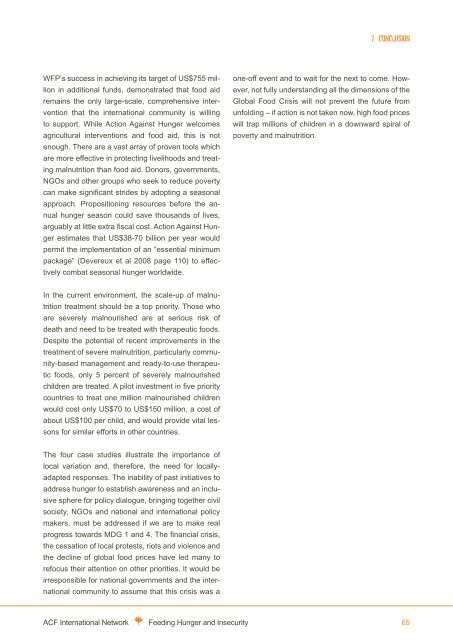Feeding hunger and insecurity
Feeding hunger and insecurity
Feeding hunger and insecurity
- No tags were found...
You also want an ePaper? Increase the reach of your titles
YUMPU automatically turns print PDFs into web optimized ePapers that Google loves.
7. conclusionWFP’s success in achieving its target of US$755 millionin additional funds, demonstrated that food aidremains the only large-scale, comprehensive interventionthat the international community is willingto support. While Action Against Hunger welcomesagricultural interventions <strong>and</strong> food aid, this is notenough. There are a vast array of proven tools whichare more effective in protecting livelihoods <strong>and</strong> treatingmalnutrition than food aid. Donors, governments,NGOs <strong>and</strong> other groups who seek to reduce povertycan make significant strides by adopting a seasonalapproach. Propositioning resources before the annual<strong>hunger</strong> season could save thous<strong>and</strong>s of lives,arguably at little extra fiscal cost. Action Against Hungerestimates that US$38-70 billion per year wouldpermit the implementation of an “essential minimumpackage” (Devereux et al 2008 page 110) to effectivelycombat seasonal <strong>hunger</strong> worldwide.one-off event <strong>and</strong> to wait for the next to come. However,not fully underst<strong>and</strong>ing all the dimensions of theGlobal Food Crisis will not prevent the future fromunfolding – if action is not taken now, high food priceswill trap millions of children in a downward spiral ofpoverty <strong>and</strong> malnutrition.In the current environment, the scale-up of malnutritiontreatment should be a top priority. Those whoare severely malnourished are at serious risk ofdeath <strong>and</strong> need to be treated with therapeutic foods.Despite the potential of recent improvements in thetreatment of severe malnutrition, particularly community-basedmanagement <strong>and</strong> ready-to-use therapeuticfoods, only 5 percent of severely malnourishedchildren are treated. A pilot investment in five prioritycountries to treat one million malnourished childrenwould cost only US$70 to US$150 million, a cost ofabout US$100 per child, <strong>and</strong> would provide vital lessonsfor similar efforts in other countries.The four case studies illustrate the importance oflocal variation <strong>and</strong>, therefore, the need for locallyadaptedresponses. The inability of past initiatives toaddress <strong>hunger</strong> to establish awareness <strong>and</strong> an inclusivesphere for policy dialogue, bringing together civilsociety, NGOs <strong>and</strong> national <strong>and</strong> international policymakers, must be addressed if we are to make realprogress towards MDG 1 <strong>and</strong> 4. The financial crisis,the cessation of local protests, riots <strong>and</strong> violence <strong>and</strong>the decline of global food prices have led many torefocus their attention on other priorities. It would beirresponsible for national governments <strong>and</strong> the internationalcommunity to assume that this crisis was aACF International Network <strong>Feeding</strong> Hunger <strong>and</strong> Insecurity 65

















